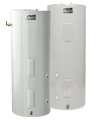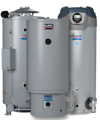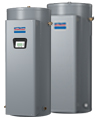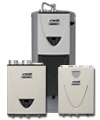WHAT DOES UEF MEAN TO YOU?
The Department of Energy implements energy conservation standards and test procedures for many appliances and equipment that we use every day, like water heaters, refrigerators, air conditioners, clothes dryers, lighting, and more. Recently, the DOE has changed the test procedures and metric used to communicate the energy efficiency of residential water heaters. The new regulation aims to make it easier to make “apples to apples” comparisons between two water heaters (within the same bin). While we haven’t made changes to our water heaters, starting June 2017, the new test and metric has changed the way we report and talk about energy efficiency, capacity and first hour rating.
ARE ALL WATER HEATERS GOING THROUGH THIS CHANGE?
All residential water heaters sold in the U.S. must comply with this new approach. Commercial water heaters are subject to different rules and regulations and are not changing at this time.
HOW WILL THIS AFFECT THE WATER HEATER’S PERFORMANCE?
Our water heaters will remain as efficient and reliable as ever. Our water heater’s delivery capacity has not changed. The DOE’s new test procedure and metric, however, will change the way that we talk about it. The amount of hot water the unit can provide in one hour of operation starting with a tank full of heated water is called First Hour Rating. In most cases, the First Hour Rating is a larger number under the new test procedures. This does not mean the water heater is providing more hot water than before. Do not substitute the new First Hour Ratings when selecting water heaters based on the requirements of the old First Hour Ratings.
WILL WATER HEATER SIZES OR DIMENSIONS CHANGE?
No. Our water heaters will still be available in the same sizes. The only thing that is changing is the way manufacturers communicate water heater performance based on new government guidelines. We will now be providing additional information about them by reporting both nominal capacity and rated storage volume. Nominal capacity refers to the general class size of a water heater. Rated storage volume refers to the exact amount of water stored in a water heater. For example, a standard ProLine® Atmospheric Vent gas water heater may have a nominal capacity of 50 gallons, and a rated storage volume of 48 gallons.
WHAT IS UEF?
The Uniform Energy Factor (UEF) is the DOE’s newly developed metric for communicating the energy efficiency of water heaters. Previously, you may have seen efficiency measured by Energy Factor (EF). UEF replaces this metric. UEF ratings are determined by assigning water heaters into one of four different categories of hot water usage and then evaluating their performance based on that usage. These categories are called bins. A water heater is assigned a UEF within its bin based upon its first hour rating. A higher UEF means a water heater is more energy efficient and will cost less to operate compared to other water heaters in the same bin. A water heater’s UEF can only be compared with water heaters within the same bin. For example a high bin water heater with a UEF of 0.95 does not perform exactly the same as that of a low bin water heater with a UEF of 0.95. Based on the bin in which a water heater is categorized, a pre-determined amount of hot water usage is applied to that water heater to determine the annual cost of operation.








